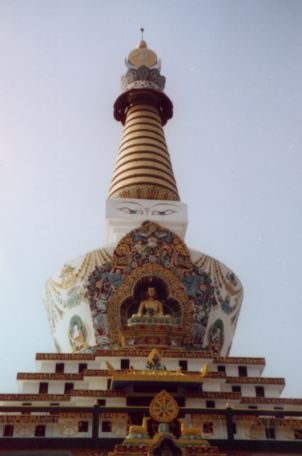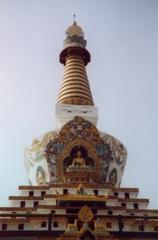
Comprehensive Guide to Visiting Salugarha Monastery, Siliguri, India
Date: 23/07/2024
Introduction
Salugarha Monastery, located in the bustling city of Siliguri, India, stands as a profound symbol of spiritual and cultural heritage. Established in the early 20th century, around 1920, this monastery has evolved into a significant center for Buddhist learning and practice. The vision of its founding figures, including the revered Lama Dorje, was to create a sanctuary that would not only preserve but also propagate the teachings of Buddha (Buddhist Tourism).
The monastery’s architectural design is a harmonious blend of traditional Tibetan and local Indian influences, making it a visual and spiritual delight. The main prayer hall, known as the Dukhang, is adorned with intricate murals and statues, reflecting the rich artistic heritage of Tibetan Buddhism. Following the Chinese invasion of Tibet in 1950, Salugarha Monastery became a refuge for Tibetan monks and laypeople, significantly enriching its cultural and religious practices (Siliguri Tourism).
This comprehensive guide delves into the rich history, cultural contributions, and practical visitor information about Salugarha Monastery, providing a well-rounded understanding for historians, travelers, and spiritual seekers alike.
Table of Contents
- Introduction
- Origins and Early History
- Architectural Development
- Role During the Tibetan Exodus
- Cultural and Educational Contributions
- Modern Developments
- Visitor Information
- Significance in Contemporary Times
- Community Engagement and Social Initiatives
- Future Prospects
- FAQ
- Conclusion
Origins and Early History
Salugarha Monastery’s origins date back to the early 20th century, around 1920, when it was established as a center for Buddhist learning and practice. The foundation was part of a broader movement to revive and sustain Buddhist traditions in the region.
Founding Figures
The founding is attributed to a group of dedicated monks and local patrons, including the revered Lama Dorje, who played a crucial role in its early development. Lama Dorje envisioned creating a space to preserve and propagate the teachings of Buddha.
Architectural Development
The architectural style reflects a blend of traditional Tibetan and local Indian influences. The main prayer hall, known as the Dukhang, is adorned with intricate murals and statues. Significant renovations took place in the 1960s, adding residential quarters for monks and a library housing ancient Buddhist texts.
Role During the Tibetan Exodus
Following the Chinese invasion of Tibet in 1950, Salugarha Monastery became a refuge for Tibetan monks and laypeople. This influx significantly influenced the cultural and religious practices at the monastery, enriching its traditions with Tibetan Buddhist rituals and ceremonies.
Cultural and Educational Contributions
The monastery established the Salugarha Monastic School, offering both secular and religious studies. It also organizes cultural events and festivals like Losar (Tibetan New Year) and Buddha Purnima, attracting visitors from across the region.
Preservation of Buddhist Texts
The monastery’s library houses a vast collection of manuscripts, scriptures, and commentaries, some centuries old. Efforts to digitize these texts have made Salugarha Monastery a vital center for Buddhist scholarship and research.
Modern Developments
The monastery has embraced modern technology, offering online courses and virtual tours. Sustainable practices like solar energy and organic farming have also been implemented to reduce its environmental footprint.
Visitor Information
- Visiting Hours: Salugarha Monastery is open daily from 6:00 AM to 6:00 PM.
- Tickets: Entry is free, but donations are welcome.
- Travel Tips: Wear modest clothing and remove shoes before entering prayer halls. Photography is allowed but avoid flash inside the prayer halls.
- Nearby Attractions: Visit the Mahananda Wildlife Sanctuary and Kali Mandir for a complete cultural experience in Siliguri.
Significance in Contemporary Times
Today, Salugarha Monastery attracts thousands of visitors annually, including tourists, pilgrims, and scholars. The serene environment and rich history offer spiritual growth and cultural enrichment.
Notable Events and Milestones
Key events include the visit of the 14th Dalai Lama in 1996 and the centenary celebration in 2020. These milestones highlight the monastery’s importance in the global Buddhist community.
Community Engagement and Social Initiatives
The monastery runs various programs aimed at improving community well-being, including healthcare camps, vocational training, and environmental conservation projects.
Future Prospects
Plans are underway to expand educational programs and enhance infrastructure. The monastery seeks to strengthen ties with other Buddhist institutions worldwide, fostering a global network of spiritual and cultural exchange.
FAQ Section
- What are the visiting hours of Salugarha Monastery?
- The monastery is open daily from 6:00 AM to 6:00 PM.
- How do I buy tickets for Salugarha Monastery?
- Entry is free, but donations are welcome.
- What should I wear when visiting Salugarha Monastery?
- Wear modest clothing and remove shoes before entering prayer halls.
- Are there any nearby attractions?
- Yes, visit the Mahananda Wildlife Sanctuary and Kali Mandir.
Conclusion
Salugarha Monastery remains a testament to the resilience and vitality of Tibetan Buddhist culture in India. Its rich history, architectural beauty, and significant contributions to education and community welfare make it a must-visit destination for anyone interested in Buddhism and Tibetan culture. The monastery’s efforts in preserving ancient Buddhist texts and its embrace of modern technology highlight its role as a vital center for Buddhist scholarship and research (Buddhist Tourism).
Despite facing challenges such as financial sustainability and the pressures of increasing tourism, Salugarha Monastery continues to thrive through strategic planning and community engagement. Future prospects include expanding educational programs and enhancing infrastructure, aimed at fostering a global network of spiritual and cultural exchange (Siliguri Tourism).
References
- Buddhist Tourism. (n.d.). https://www.buddhist-tourism.com
- Siliguri Tourism. (n.d.). https://www.siliguritourism.com
